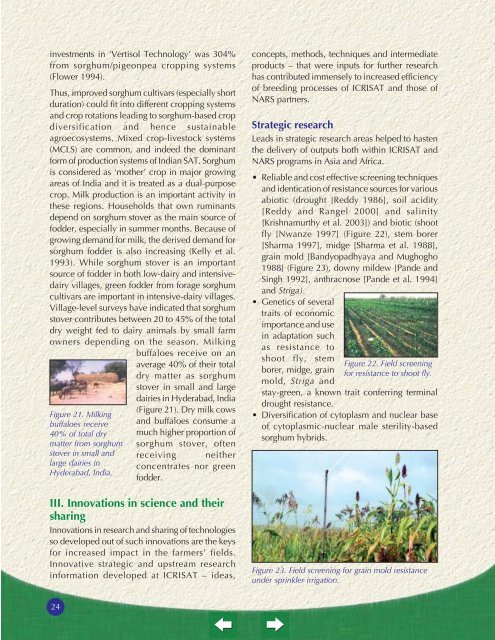Sorghum - icrisat
Sorghum - icrisat
Sorghum - icrisat
Create successful ePaper yourself
Turn your PDF publications into a flip-book with our unique Google optimized e-Paper software.
investments in ‘Vertisol Technology’ was 304%<br />
from sorghum/pigeonpea cropping systems<br />
(Flower 1994).<br />
Thus, improved sorghum cultivars (especially short<br />
duration) could fit into different cropping systems<br />
and crop rotations leading to sorghum-based crop<br />
diversification and hence sustainable<br />
agroecosystems. Mixed crop-livestock systems<br />
(MCLS) are common, and indeed the dominant<br />
form of production systems of Indian SAT. <strong>Sorghum</strong><br />
is considered as ‘mother’ crop in major growing<br />
areas of India and it is treated as a dual-purpose<br />
crop. Milk production is an important activity in<br />
these regions. Households that own ruminants<br />
depend on sorghum stover as the main source of<br />
fodder, especially in summer months. Because of<br />
growing demand for milk, the derived demand for<br />
sorghum fodder is also increasing (Kelly et al.<br />
1993). While sorghum stover is an important<br />
source of fodder in both low-dairy and intensivedairy<br />
villages, green fodder from forage sorghum<br />
cultivars are important in intensive-dairy villages.<br />
Village-level surveys have indicated that sorghum<br />
stover contributes between 20 to 45% of the total<br />
dry weight fed to dairy animals by small farm<br />
owners depending on the season. Milking<br />
buffaloes receive on an<br />
average 40% of their total<br />
dry matter as sorghum<br />
stover in small and large<br />
dairies in Hyderabad, India<br />
Figure 21. Milking<br />
buffaloes receive<br />
40% of total dry<br />
matter from sorghum<br />
stover in small and<br />
large dairies in<br />
Hyderabad, India.<br />
(Figure 21). Dry milk cows<br />
and buffaloes consume a<br />
much higher proportion of<br />
sorghum stover, often<br />
receiving neither<br />
concentrates nor green<br />
fodder.<br />
III. Innovations in science and their<br />
sharing<br />
Innovations in research and sharing of technologies<br />
so developed out of such innovations are the keys<br />
for increased impact in the farmers’ fields.<br />
Innovative strategic and upstream research<br />
information developed at ICRISAT – ideas,<br />
concepts, methods, techniques and intermediate<br />
products – that were inputs for further research<br />
has contributed immensely to increased efficiency<br />
of breeding processes of ICRISAT and those of<br />
NARS partners.<br />
Strategic research<br />
Leads in strategic research areas helped to hasten<br />
the delivery of outputs both within ICRISAT and<br />
NARS programs in Asia and Africa.<br />
• Reliable and cost effective screening techniques<br />
and identication of resistance sources for various<br />
abiotic (drought [Reddy 1986], soil acidity<br />
[Reddy and Rangel 2000] and salinity<br />
[Krishnamurthy et al. 2003]) and biotic (shoot<br />
fly [Nwanze 1997] (Figure 22), stem borer<br />
[Sharma 1997], midge [Sharma et al. 1988],<br />
grain mold [Bandyopadhyaya and Mughogho<br />
1988] (Figure 23), downy mildew [Pande and<br />
Singh 1992], anthracnose [Pande et al. 1994]<br />
and Striga).<br />
• Genetics of several<br />
traits of economic<br />
importance and use<br />
in adaptation such<br />
as resistance to<br />
shoot fly, stem<br />
borer, midge, grain<br />
mold, Striga and<br />
Figure 22. Field screening<br />
for resistance to shoot fly.<br />
stay-green, a known trait conferring terminal<br />
drought resistance.<br />
• Diversification of cytoplasm and nuclear base<br />
of cytoplasmic-nuclear male sterility-based<br />
sorghum hybrids.<br />
Figure 23. Field screening for grain mold resistance<br />
under sprinkler irrigation.<br />
24
















